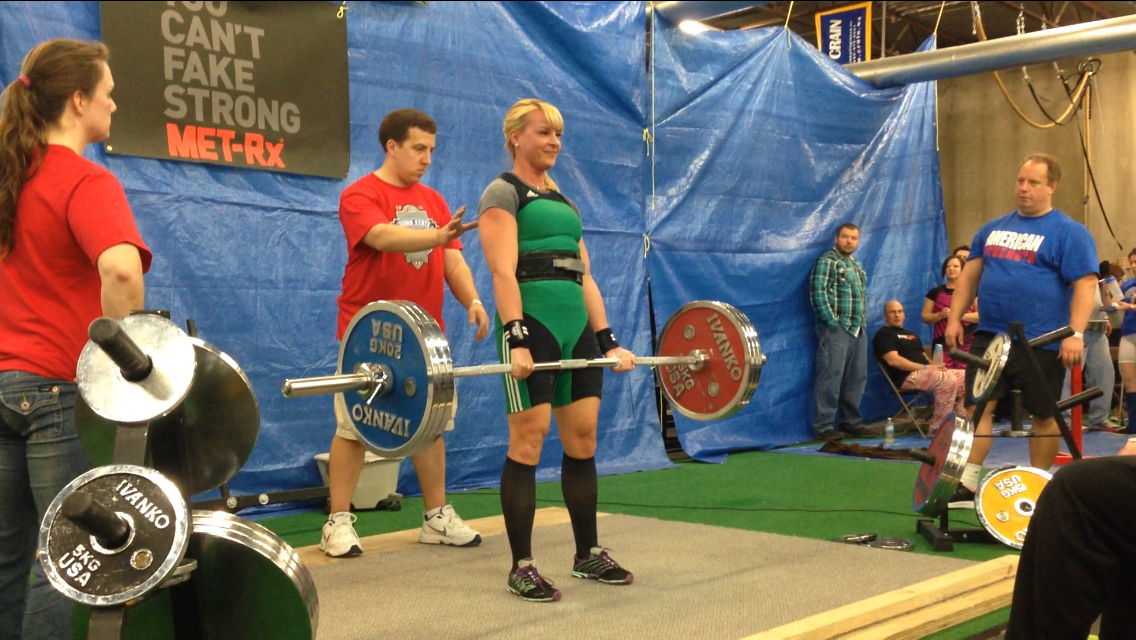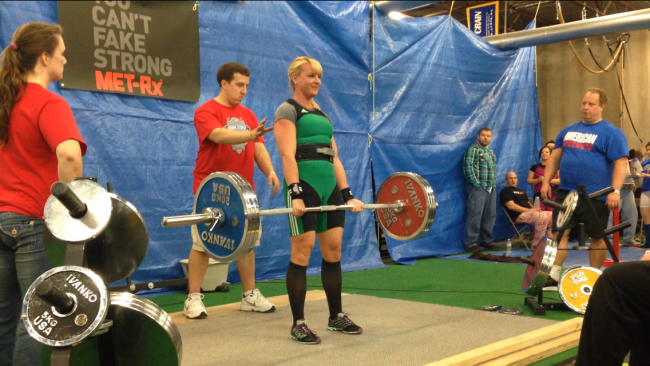
Read how to use Biofeedback in Competition
It was the middle of last week and I was worried. I just happened to be walking by the door to the training floor at The Movement Minneapolis at the exact moment that my wife, Jen Sinkler, took a pull on a heavily loaded bar, barely broke it off the ground, and then knelt on the ground behind it. I did a double take, took two steps back into the doorway, and said: “What was that?”
“Oh, ahh, nothing, totally fine,” came her response.
It did not look fine to me.
One thing I know about Jen is that she doesn’t show, or even admit, for that matter, weakness when it comes to competition – and the powerlifting contest she had been training for was a mere five days away. I asked about it later and was met with more insistence that everything was fine and that her “hip flexors were just tight.”
I didn’t give it any more thought until six of nine lifts were in the books and Jen was going into the deadlift with a 2.5-kilogram lead against her arch rival. It’s also worth mentioning that because of a rule change in weight classes, any records broken at this meet would have their holder’s names in the Minnesota state record books forever. She already held the squat record and she was going for the deadlift and total record.
But her hips were in pain. She pulled a little over 138 kg (305 pounds) in her normal competition sumo stance in the warm-up area and it was suspiciously slow and effortful.
To even maintain her lead, she was going to have to deadlift something equal to or greater than her previous meet lifetime PR of 162.5 kg (358.2 pounds), and her rival was opening 7.5 kg (roughly 16 pounds) higher than she was. She needed big pulls, and she wasn’t looking to be in any kind of shape to pull big.
“It’s really hurting my hip flexors at the bottom of the pull now,” she said.
On a hunch, I asked, “How does conventional test?”
Even the best of us forget the basics sometimes, and Jen hadn’t considered questioning her premise that sumo was her best competition stance. She took a few seconds to run through the testing protocol and discovered that sumo tested terribly, while conventional tested extremely well. She went back to the 138 kg bar, pulled it conventional, and tested. Not only did the weight fly up, but it tested extremely well.
Jen walked out onto the platform and confidently pulled 147.5 kg (325 pounds), then 160 kg (353 pounds), and then 165 kg (364 pounds) to seal a lifetime deadlift PR, the state deadlift record, the total record, the middleweight win, and the meet’s best lifter award. Her rival pulled 162.5 kg (358 pounds), a pull that would have likely given her the win, resulting in her name in the record book, had Jen not switched her style of deadlifting that day.

Up to that point there were many factors to thank for getting her there. Chad Wesley Smith’s Juggernaut programming, which had a squat emphasis, put 15 kg on her total. Advice from some other badass female lifters helped her cut a few pounds and make her weight class. Her lifting partners provided encouragement and support to keep her training consistent.
But none of that would have mattered had she not tested her movement before stepping out on the platform. She had been doing too much of the same thing, she was in pain, and there is no way she would have pulled a lifetime PR deadlift in that condition. She may have even injured herself.
Biofeedback for the win, indeed.
You know, it’s funny, every once in a while some jackass, thinking they’re finding a flaw in the system, will ask me, “Well, what if something doesn’t test well on meet day, do you just tell them you can’t lift that day?” And the answer is, no, you step out on the platform and you do what you have to do no matter what – because it’s competition. But, if you can adjust your game and make better decisions because of biofeedback, then you’re not at a disadvantage: instead, you’re gaining a massive competitive advantage.
This isn’t the first time I’ve seen this play out, but it is certainly one of the most dramatic.
And, it came as a wonderful punctuation to last week’s Off The Floor anniversary sale that ended this weekend. (I extended it for a couple days because of Jen’s victory.)
Ultimately, if you’ve been on the fence about biofeedback testing, I want you to ask yourself if you’re going to question your premises or stay where you are.
If you already have been testing and following your body, then I have a challenge for you: what things are you not questioning that could get you better results?
The quality of your answers depends on the quality of your questions.
P.S. Thank you to everyone who picked up OTF last week. Your support means the world to me, and allows me to continue doing what I love and providing great information.


Leave a Reply